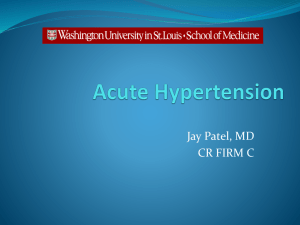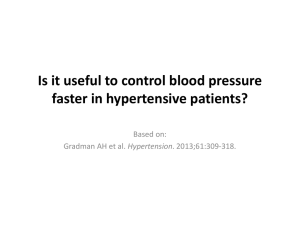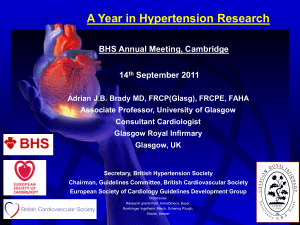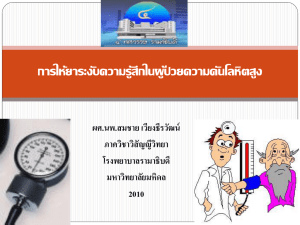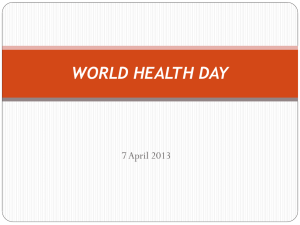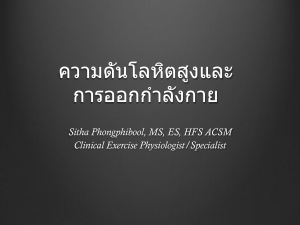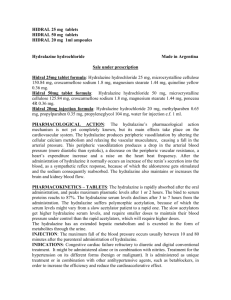Choice of antihypertensive for PE-E, Peter von Dadelszen
advertisement
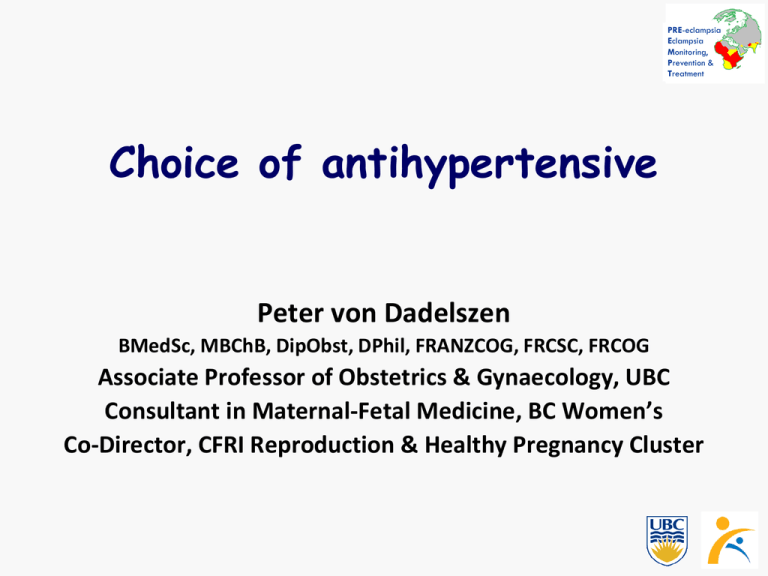
PRE-eclampsia Eclampsia Monitoring, Prevention & Treatment Choice of antihypertensive Phone: +1-604-875-305 Peter von Dadelszen BMedSc, MBChB, DipObst, DPhil, FRANZCOG, FRCSC, FRCOG Associate Professor of Obstetrics & Gynaecology, UBC Consultant in Maternal-Fetal Medicine, BC Women’s Co-Director, CFRI Reproduction & Healthy Pregnancy Cluster Christchurch PRE-EMPT (PRE-eclampsia-Eclampsia Monitoring, Prevention & Treatment) • Five objective, LMIC community interventionfocussed, pre-eclampsia project • Funding: – Bill & Melinda Gates Foundation Why use antihypertensives? • Maternal stroke risk associated with both severe systolic and/or diastolic hypertension – sBP >160mmHg – dBP >110mmHg CEMACH 2007 • Severe hypertension associated with placental abruption and attendant maternal and perinatal risks • Severe hypertension is included in most definitions of ‘severe’ pre-eclampsia, although such classification systems are flawed Menzies et al. Hypertens Pregnancy 2007 Why use antihypertensives? • In non-severe pregnancy hypertension – No clear evidence of benefit other than to reduce the frequency of episodes of severe hypertension – May adversely effect fetal growth velocity von Dadelszen et al. Lancet 2000 • Therefore, my focus will be on the pharmacological management of severe hypertension The ‘ideal’ agent in rural & remote settings • • • • • Oral administration Reliable reduction in BP Smooth reduction in BP Rapid onset of action Minimal overshoot – BP in target range • sBP 130-160mmHg • dBP 80-110mmHg From what can we choose? • Hydralazine • Beta-blockers (& alpha-/beta-blockers) – Atenolol – Labetalol • Calcium channel blockers – Nifedipine • Alpha-methyldopa • Angiotensin converting enzyme inhibitors • Angiotensin-II receptor blockers From what can we choose? • Hydralazine • Beta-blockers (& alpha-/beta-blockers) – Atenolol – Labetalol • Calcium channel blockers – Nifedipine • Alpha-methyldopa • Angiotensin converting enzyme inhibitors • Angiotensin-II receptor blockers – Risks of fetal renal toxicity and IUFD From what can we choose? • MgSO4 is NOT an antihypertensive The ‘ideal’ agent in rural & remote settings • • • • • Oral administration Reliable reduction in BP Smooth reduction in BP Rapid onset of action Minimal overshoot – BP in target range • sBP 130-160mmHg • dBP 80-110mmHg Oral administration • Atenolol – No adverse effects on fetal growth when used acutely • • • • Labetalol Methyldopa Nifedipine capsules Nifedipine intermediate acting – PA/Retard • Hydralazine Modified from: Magee & Abdullah. Expert Opin Drug Saf 2004 The ‘ideal’ agent in rural & remote settings • • • • • Oral administration Reliable reduction in BP Smooth reduction in BP Rapid onset of action Minimal overshoot – BP in target range • sBP 130-160mmHg • dBP 80-110mmHg Reliable reduction in BP severe hypertension • CCBs are more reliable than hydralazine in lowering BP in pregnant women with severe hypertension Magee et al. BMJ 2004 Duley et al. CDSR 2006 • Hydralazine appears more reliable than labetalol Magee et al. BMJ 2004 • Methyldopa may be an agent of choice for severe hypertension Duley et al. CDSR 2006 Reliable reduction in BP severe hypertension • CCBs are more reliable than hydralazine in lowering BP in pregnant women with severe hypertension Magee et al. BMJ 2004 Duley et al. CDSR 2006 • Hydralazine appears more reliable than labetalol Magee et al. BMJ 2004 • Methyldopa may be an agent of choice for severe hypertension Magee et al. BMJ 2004 Reliable reduction in BP severe hypertension • CCBs are more reliable than hydralazine in lowering BP in pregnant women with severe hypertension Magee et al. BMJ 2004 Duley et al. CDSR 2006 • Hydralazine appears more reliable than labetalol Magee et al. BMJ 2004 • Methyldopa may be an agent of choice for severe hypertension – Widely used – routinely on EMLs The ‘ideal’ agent in rural & remote settings • • • • • Oral administration Reliable reduction in BP Smooth reduction in BP Rapid onset of action Minimal overshoot – BP in target range • sBP 130-160mmHg • dBP 80-110mmHg Smooth reduction in BP • The ideal agent will reduce BP effectively and over a relatively short period of time – <60min – Stabilise and reduce MAP by 10% per hour • BP fall will not be precipitous – Adverse maternal CNS effects – Adverse fetal effects Normal Pregnancy Early-onset pre-eclampsia The ‘ideal’ agent in rural & remote settings • • • • • Oral administration Reliable reduction in BP Smooth reduction in BP Rapid onset of action Minimal overshoot – BP in target range • sBP 130-160mmHg • dBP 80-110mmHg ‘Rapid’ onset of action Drug Dosage Onset Peak Duration 24hr Atenolol 25 – 50 mg 1hr 2-4hr Labetalol 200 mg 20min – 2hr 1-4 hr 500 mg – 2 g 40 min 3-6hr 12-24hr 10 mg 30min 4hr 12hr 5 – 10 mg 5-10min 30min 6.5hr Methyldopa Nifedipine PA (or retard) Nifedipine capsule (dose dependent) 8-12hr (dose dependent) Modified from: Magee & Abdullah. Expert Opin Drug Saf 2004 The ‘ideal’ agent in rural & remote settings • • • • • Oral administration Reliable reduction in BP Smooth reduction in BP Rapid onset of action Minimal overshoot – BP in target range • sBP 130-160mmHg • dBP 80-110mmHg Minimal overshoot • CCBs less likely to cause overshoot than hydralazine Magee et al. BMJ 2004 • Beta-blockers less likely to cause overshoot than hydralazine Magee et al. BMJ 2004 • Nifedipine PA/Retard less likely to cause overshoot than capsules? Brown et al. AJOG 2002 – Small RCT – End-point (‘in range BP’) measured at time PA approaching maximal effect On balance • An intervention package should include 1 - 3 oral antihypertensive agent(s) • The choice for a single antihypertensive lies between methyldopa, nifedipine, and another beta-blocker, probably atenolol – labetalol is not on EMLs • Theoretical and practical reasons to have all available – Combined CNS control, beta-blockade and vasodilatation – Second effective agent for women whose BP is resistant to another agent • Reserve i.v. hydralazine for obtunded/comatose women PRE-EMPT Objective 3 • CLIP (Community-Level Interventions for Pre-eclampsia) – Cluster randomised controlled trial of community level interventions for women with pre-eclampsia – Aims • Can – identification, – early risk stratification, and – initiation of life-saving treatment at the community level • decrease pre-eclampsia-related maternal and perinatal mortality in LMIC? CLIP • Intervention – CLIP package of care • Case recognition & triage • Treatment of severe hypertension (sBP ≥160mmHg) – Oral antihypertensive ? Atenolol; ? Nifedipine, ? Methyldopa – Intramuscular MgSO4 (5g each buttock) • Treatment of eclampsia – Intramuscular MgSO4 (5g each buttock) • Transfer into facilities offering evidence-based care – Setting • Community – community health workers • Primary health units (not repeated) The ‘ideal’ agent in rural & remote settings • • • • • Oral administration Reliable reduction in BP Smooth reduction in BP Rapid onset of action Minimal overshoot – BP in target range • sBP 130-160mmHg • dBP 80-110mmHg
